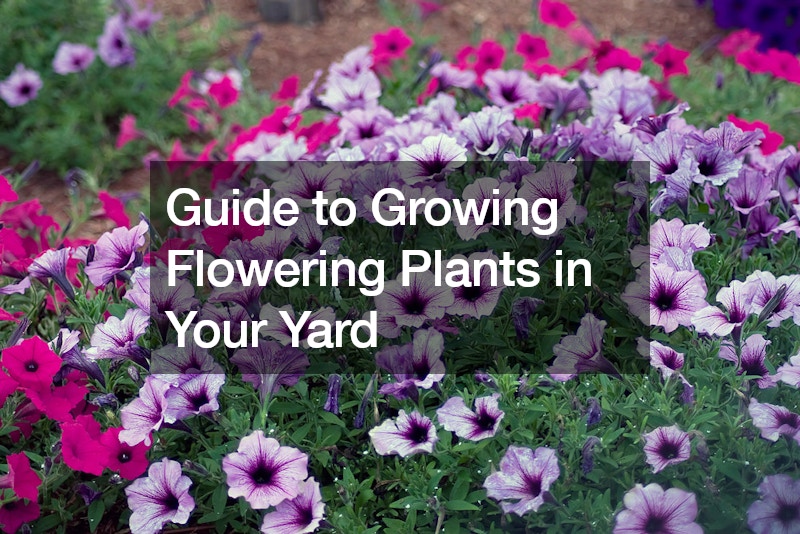
Cultivating a garden brimming with colorful blooms is a fulfilling endeavor that can elevate your outdoor space into a vibrant sanctuary of natural beauty. Whether you’re a seasoned gardener or new to the craft, growing flowering plants in your yard is achievable with the right approach. This guide delves into the essential steps to successfully nurture and cultivate flowering plants in your garden, including utilizing bulk flower seeds to maximize variety and affordability.
Plan Your Garden: Before planting, meticulously plan your garden layout considering factors like sunlight exposure, soil type, and drainage.
Sketch out a rough design, considering the size and growth habits of each plant variety.
Select the Right Plants: Choose flowering plants suited to your local climate and growing conditions. Research different species and varieties, factoring in bloom time, height, color, and fragrance to create a diverse garden.
Prepare the Soil: Proper soil preparation is vital. Loosen garden soil and enrich it with organic matter like compost to enhance structure, fertility, and drainage.
Sow Bulk Flower Seeds: Opt for bulk flower seeds to diversify your garden affordably. Follow seed packet instructions for planting depth and spacing to ensure successful growth.
Provide Adequate Water and Sunlight: Most flowering plants need ample sunlight. Choose a sunny location and water regularly, avoiding waterlogged soil.
Mulch and Fertilize: Apply organic mulch to retain moisture and suppress weeds. Regularly fertilize with a balanced fertilizer to promote healthy growth and blooms.
Monitor and Maintain: Keep an eye on your garden for pests, diseases, or nutrient deficiencies. Remove weeds promptly and deadhead spent flowers to encourage continuous blooming.
Enjoy Your Garden: Take time to appreciate your garden’s beauty as it blooms. Share the joy of gardening with loved ones and consider saving seeds from favorite plants for future seasons.
Consider Companion Planting: Companion plants can enhance the health of your flowering plants. Strategically place plants that benefit each other, such as marigolds alongside tomatoes for pest control.
Attract Beneficial Insects: Encourage beneficial insects like ladybugs and hoverflies by planting nectar-rich flowers. They provide natural pest control and pollination services.
Provide Support for Climbing Plants: Ensure climbing plants have proper support structures like trellises or stakes to prevent damage and enhance aesthetic appeal.
Practice Sustainable Gardening: Embrace sustainable practices to minimize environmental impact. Use organic fertilizers and pesticides, implement water-saving techniques, and consider native plants to support local wildlife.
ewarding pursuit. By following these steps and incorporating bulk flower seeds, you can create a stunning garden bursting with blooms. So, dive into gardening, and watch your garden flourish!
In addition to the essential steps outlined above, there are further considerations and practices that can enhance your experience of growing flowering plants in your yard.
Firstly, when planning your garden layout, think about incorporating different heights and textures to create visual interest. Tall plants like delphiniums or hollyhocks can be placed towards the back of borders, while shorter plants like marigolds or petunias can be used as edging plants along paths or in front of taller specimens. Mixing in some ornamental grasses can add movement and structure to your garden beds.
Furthermore, don’t overlook the importance of timing when it comes to planting your flowering garden. Depending on your climate and the specific requirements of the plants you choose, you may need to stagger your planting times to ensure a continuous display of blooms throughout the growing season. This can involve planting early spring bulbs like tulips or daffodils, followed by summer annuals like zinnias or cosmos, and then transitioning to fall-blooming perennials like asters or sedum.
Additionally, consider the environmental impact of your gardening practices. In addition to using organic fertilizers and pesticides, you can further reduce your carbon footprint by composting kitchen scraps and yard waste to create nutrient-rich soil amendments for your garden. Collecting rainwater in barrels or installing a drip irrigation system can also help conserve water and reduce runoff.
Finally, don’t be afraid to get creative and experiment with different plant combinations and design ideas in your garden. Gardening is as much art as it is science, and there’s no right or wrong way to create a beautiful and functional outdoor space. Whether you prefer a formal English garden with neatly clipped hedges and geometric beds or a wildflower meadow bursting with color and life, let your imagination be your guide and have fun expressing yourself through your garden.
In conclusion, growing flowering plants in your yard offers a wealth of opportunities for creativity, relaxation, and connection with nature. By following the steps outlined in this guide and incorporating bulk flower seeds into your gardening plans, you can cultivate a stunning and sustainable garden that brings joy and beauty to your outdoor space year after year. So roll up your sleeves, dig in the dirt, and let your garden dreams take root!
.

